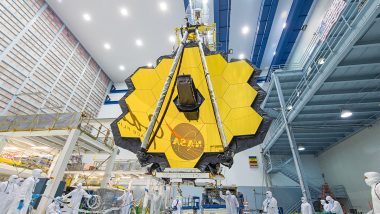Washington, January 8: The James Webb Space Telescope, the largest and most powerful space telescope ever constructed, completed its deployment on Saturday morning, announced National Aeronautics and Space Administration (NASA) and the mission controllers. The giant golden mirror unfolded fully about 700,000 miles from Earth that lift off on Christmas Day.
"The final wing is now deployed! Before we celebrate, we've still got work to do. The team is working hard at @SpaceTelescope to latch the wing into place, a multi-hour process. When the final latch is secure, #NASAWebb will be fully unfolded in space. #UnfoldTheUniverse," tweeted NASA Web Telescope.
The ten billion dollar project spanning over three decades, a collaboration between NASA, the European Space Agency and the Canadian Space Agency, hopes to look further back in time than ever before - to find out more about the creation of the first stars and the beginnings of our Universe. NASA's Webb Telescope Reaches Major Milestone as 'Mirror Unfolds'.
Saturday's deployment began at 9 a.m. EST with teams of engineers sending commands to Webb to release latches first. The mirror-unfolding process only takes about 5 minutes, but locking it in place took about 2 hours, according to NASA. After several technical and weather delays, the James Webb Space Telescope launched on a European Ariane launcher from French Guiana.
The final steps on Saturday wrapped up the most significant preparations to use the telescope - unfolding sun shields, mirrors, radiators and sensors. The unfolding process involved thousands of parts that must work perfectly in the right sequence. There are no cameras aboard but fortunately, each step can be controlled from the ground in case there are issues.
"Webb is an extraordinary mission," said NASA administrator Bill Nelson. "It's a shining example of what we can accomplish when we dream big. We've always known that this project would be a risky endeavor. But, of course, when you want a big reward, you have to usually take a big risk," he added.
Once cold enough, and with the help of a star as a target, tiny motors will be used by our team to precisely align and shape each segment so all 18 will perform as one mirror, according to NASA Web Telescope.
Further, the telescope is equipped with a segmented mirror that can extend 21 feet and 4 inches (6.5 meters) -- a massive length that will allow the mirror to collect more light from the objects it observes once the telescope is fully deployed and operational at L2. The more light the mirror can collect, the more details the telescope can observe.
Watch Video:
The concept for the telescope was first imagined as a successor to Hubble at a workshop in 1989, and construction on Webb first began in 2004. Since then, thousands of scientists, technicians and engineers from 14 countries have spent 40 million hours building the telescope. James Webb Space Telescope’s Secondary Mirror Deployed And Locked, Confirms NASA.
Now, Webb could help researchers understand the origins of the universe and begin to answer key questions about our existence, such as where we came from and if we're alone in the cosmos.
The James Webb Space Telescope is the scientific complement to NASA's Hubble Space Telescope. It will be the most powerful space telescope ever built. Webb is an international project led by NASA with its partners, ESA (European Space Agency) and the CSA (Canadian Space Agency. (ANI)
(The above story is verified and authored by ANI staff, ANI is South Asia's leading multimedia news agency with over 100 bureaus in India, South Asia and across the globe. ANI brings the latest news on Politics and Current Affairs in India & around the World, Sports, Health, Fitness, Entertainment, & News. The views appearing in the above post do not reflect the opinions of LatestLY)













 Quickly
Quickly


